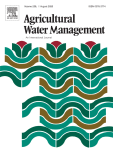View Item
- xmlui.general.dspace_homeCentros Regionales y EEAsCentro Regional Mendoza - San JuanEEA San JuanArtículos científicosxmlui.ArtifactBrowser.ItemViewer.trail
- DSpace Home
- Centros Regionales y EEAs
- Centro Regional Mendoza - San Juan
- EEA San Juan
- Artículos científicos
- View Item
Spring deficit irrigation in olive (cv. Genovesa) growing under arid continental climate: effects on vegetative growth and productive parameters
Abstract
This study was aimed to evaluate the effect of regulated deficit irrigation (RDI), applied from mid-spring to early summer, on physiological parameters, vegetative growth and productivity in an intensive hedgerow olive orchard located in a non-traditional (marked winter-spring water-deficit) olive growing region. The experiments were carried out during three crop seasons by using four years old (7 m × 3.5 m) ‘Genovesa’ olive trees. Three RDI treatments
[ver mas...]
This study was aimed to evaluate the effect of regulated deficit irrigation (RDI), applied from mid-spring to early summer, on physiological parameters, vegetative growth and productivity in an intensive hedgerow olive orchard located in a non-traditional (marked winter-spring water-deficit) olive growing region. The experiments were carried out during three crop seasons by using four years old (7 m × 3.5 m) ‘Genovesa’ olive trees. Three RDI treatments (T25, T50 and T75) were applied as a percentage of crop evapotranspiration (25, 50 and 75% ETc, respectively) during the period from fruit set to pit hardening. Also, a control treatment was irrigated at 100% ETc during the whole crop season. Under the analyzed environmental conditions, stomatal conductance was less sensitive in young leaves than in mature leaves against changes in water availability. This fact should be considered when being used as benchmarks in olives trees submitted to water deprivation during periods with marked water constraint. Regarding vegetative parameters, significant reductions in apical vegetative shoot growth, trunk cross-sectional area and canopy volume were found in less irrigated treatments (T25 and T50) with respect to most irrigated ones (T75 and T100). Moreover, the strongest effects of deficit irrigation were observed when pruning was applied at the end of the second crop season evaluated. Both fruit and oil yields were barely affected by water availability. Although in the first crop season evaluated the fruit yield was greater in the full-irrigation treatment – which could be due to the age of the olive trees -, at the end of the whole experimental period (three crop years) the mean values from this yield component did not present significant differences among all irrigation treatments. Similarly, water availability did not affect oil yield (kg/ha); no significant differences were found among irrigation treatments in any of the crop seasons analyzed. The effects of water availability on productive parameters were more evident when analyzed as an estimated productive response; the total water productivity, calculated on both fruit weight and oil weight bases, gave the highest values in the most restrictive irrigation treatment. Overall, findings from this study could be of interest for olive cultivation in regions with dry spring period and for intensive hedgerow orchards suited to over-row harvesters. Imposing water restriction during this period could be suitable for achieving sustainable fruit and oil productivity while saving considerable amount of irrigation water.
[Cerrar]

Author
Pierantozzi, Pierluigi;
Torres, Myriam Mariela;
Tivani, Martín;
Contreras Valentín, Ana Cibeles;
Gentili, Luciana;
Parera, Carlos Alberto;
Maestri, Damian;
Fuente
Agricultural Water Management 238 : 106212 (August 2020)
Date
2020-05-05
Editorial
Elsevier
ISSN
0378-3774
Formato
pdf
Tipo de documento
artículo
Palabras Claves
Derechos de acceso
Restringido
 Excepto donde se diga explicitamente, este item se publica bajo la siguiente descripción: Creative Commons Attribution-NonCommercial-ShareAlike 2.5 Unported (CC BY-NC-SA 2.5)
Excepto donde se diga explicitamente, este item se publica bajo la siguiente descripción: Creative Commons Attribution-NonCommercial-ShareAlike 2.5 Unported (CC BY-NC-SA 2.5)

